Analyze and discuss the impact of elements used in a particular commercial.
- Subject:
- Media and Communications
- Material Type:
- Lesson
- Author:
- Utah Lesson Plans
- Date Added:
- 10/12/2021
Analyze and discuss the impact of elements used in a particular commercial.
Analyze and discuss the impact of elements used in a particular commercial.

Students are often asked to perform speeches, but rarely do we require students to analyze speeches as carefully as we study works of literature. In this unit, students are required to identify the rhetorical strategies in a famous speech and the specific purpose for each chosen device. They will write an essay about its effectiveness and why it is still famous after all these years.

By analyzing Dear Abby's rant about bad grammar usage, students become aware that attitudes about race, social class, moral and ethical character, and "proper" language use are intertwined.
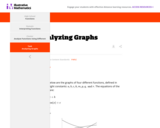
This task could be used as a review problem or as an assessment problem after many different types of functions have been discussed. Since the different parameters of the functions are not given explicitly, the focus is not just on graphing specific functions but rather students have to focus on how values of parameters are reflected in a graph.
Students use the Informational Text Analysis Tool to deconstruct the essential elements of informational text.

Students analyze a letter written by Jackie Robinson to the White House in 1972. Students are guided to understand that racial equality still had not been achieved during this time. Students analyze tone, audience and context and draw conclusions. Background about Jackie Robinson's role in the Civil Rights movement should be provided to students.
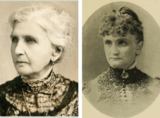
In this lesson, students will analyze primary source excerpts from various viewpoints. Students will use these sources to interpret why most Utah women’s voting rights were granted, rescinded, and returned between 1870 and the achievement of statehood in 1896.
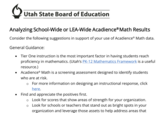
Analyzing School-Wide or LEA-Wide Acadience Math Results is a guiding document that suggests methods for analyzing and understanding Acadience Math results for a whole school or district.

Students apply the analytical skills that they use when reading literature to an exploration of the underlying meaning and symbolism in Hieronymous Bosch's early Renaissance painting "Death and the Miser".
Students individually consider a visual text and draw conclusions based on what they see. They write about their conclusions and explain the evidence used to make that determination.
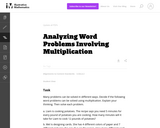
In this task, the students are not asked to find an answer, but are asked to analyze word problems and explain their thinking. In the process, they are faced with varying ways of thinking about multiplication.

Students analyze a photograph of child laborers and make inferences about the impact of the photograph on the photographer based on the message he was trying to convey. Background information about child workers during the Progressive Era included.

This is an activity that involves analyzing a map of the Louisiana Purchase. Guiding questions are offered.
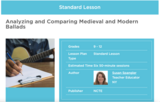
Students explore the ballads genre by reading medieval ballads to deduce their characteristics, acting out the ballads, comparing medieval and modern ballads using Venn diagrams, and composing their own ballads.

Students analyze images of Oscar Wilde used to publicize his 1882 American lecture tour. They then compare a caricature to another researched image, sharing this analysis in a podcast.

It is important for students to know how to evaluate messages conveyed by the news media. Exploration of the artistic techniques used in political cartoons leads to critical questioning.

In this ELA lesson, students will use their analytical skills to determine the causes of the rise and fall of the Shaker religious community. After watching a series of documentary clips, students examine and document the group's origins, successes, hardships, and eventual decline.

Students explore and analyze the techniques that political (or editorial) cartoonists use and draw conclusions about why the cartoonists choose those techniques to communicate their messages.

This informational text explains that while both the Arctic and Antarctica are cold, Antarctica is much colder and drier - a polar desert. The text is written at a grades four through five reading level. This version is a full-color PDF that can be printed, cut and folded to form a book. Each book contains color photographs and illustrations.